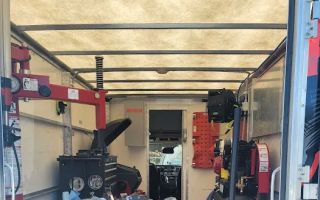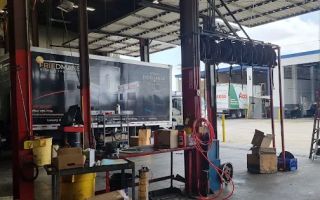- Recognizing Brake Failure Signs Before It Happens
- Immediate Actions If Your Car Brakes Fail on the Road
- Advanced Techniques for Slowing Down Safely
- Calling for Help and Roadside Assistance
- Real-Life Stories and Lessons from Brake Failure Incidents
- Professional Services to Keep You Safe
1. Recognizing Brake Failure Signs Before It Happens
Brake failure on the road is one of the most dangerous situations a driver can encounter. Knowing what to do if your car’s brakes fail on the road starts with early recognition of warning signs. These signs might include a spongy or soft brake pedal, unusual noises like grinding or squealing, a burning smell, or a noticeable increase in stopping distance.
For example, some drivers notice their brake pedal sinks to the floor or feels less responsive before a total failure occurs. Spotting these symptoms early allows you to take preventive actions like reducing speed and preparing for emergency maneuvers.

AutoZone Auto Parts
5701 Broadway, Bronx, NY 10463, USA
1.1 Preventive Maintenance is Key
Regular brake inspections and maintenance are crucial to reduce the risk of brake failure. Ensuring brake pads, rotors, and brake fluid levels are in good condition is a fundamental part of vehicle safety. Many brake failures could be prevented with timely servicing.

Pick Your Part - Help Yourself
1232 Blinn Ave, Wilmington, CA 90744, USA
2. Immediate Actions If Your Car Brakes Fail on the Road
If you find yourself in the terrifying situation where your brakes fail while driving, immediate and calm action is vital. Panic can worsen the outcome, but following a step-by-step approach can help you regain control and minimize risk.
2.1 Stay Calm and Alert
The first instinct might be to panic, but staying calm allows you to think clearly. Keep your eyes on the road and assess the traffic around you. Avoid sudden swerves that could cause loss of control.
2.2 Use Engine Braking
Shift the car into a lower gear to use engine braking to reduce speed. In manual cars, downshift gradually. In automatics, shift to “L” or “2” to slow the car without relying on the brakes. This method helps slow your vehicle safely.
2.3 Pump the Brake Pedal
If your brake pedal feels soft or goes to the floor, try pumping it rapidly to build up pressure. Sometimes this technique temporarily restores some braking power, allowing you to stop or slow down enough to steer safely.
3. Advanced Techniques for Slowing Down Safely
Beyond basic steps, there are additional strategies to control your car when brakes fail, especially in high-risk scenarios like downhill driving or heavy traffic.
3.1 Use the Emergency or Parking Brake
Carefully and gradually apply the emergency brake. This brake operates separately from the main system and can help slow your car, but avoid pulling it suddenly, which might cause the wheels to lock and skid.
3.2 Steer Towards Safe Areas
Look for safe zones such as the shoulder, an uphill incline, or grassy areas where you can bring the vehicle to a stop more safely. Using natural resistance like an incline helps reduce speed.
3.3 Alert Other Drivers
Turn on your hazard lights immediately to warn other motorists. If you have access to your horn, use it intermittently to signal distress without causing panic.
4. Calling for Help and Roadside Assistance
Once you have managed to slow down or stop safely, the next crucial step is to get professional help. Brake failure requires expert diagnosis and repair before you resume driving.
4.1 Contacting Reliable Services
Calling roadside assistance services ensures you receive quick, professional aid. Companies like Rescue & Towing specialize in emergency vehicle support, providing services from towing to on-site brake troubleshooting. Having their contact ready before emergencies can save precious time and reduce stress.
4.2 Providing Clear Information
When calling for help, clearly describe your location, the nature of the brake failure, and any immediate hazards. This enables responders to arrive equipped and prepared to handle the situation safely.
5. Real-Life Stories and Lessons from Brake Failure Incidents
Consider the case of Linda, who experienced brake failure while driving downhill on a mountainous road. Thanks to her quick thinking—shifting to a low gear and using the emergency brake gradually—she was able to steer to a safe pull-off area. Calling roadside assistance afterwards ensured her vehicle was inspected and repaired before she continued her journey.
In contrast, a widely reported accident in a metropolitan area occurred because the driver failed to remain calm and used abrupt braking attempts, causing a multi-car collision. This incident highlights the importance of composure and technique during brake failure emergencies.
5.1 Lessons Learned
These stories emphasize preparedness: understanding what to do if your car’s brakes fail on the road and having access to professional help is critical. Routine maintenance combined with knowledge of emergency steps can be lifesaving.
6. Professional Services to Keep You Safe
Brake failure emergencies require expert intervention. Rescue & Towing offers reliable roadside assistance tailored to brake system failures and other mechanical issues. Their professional teams ensure your safety and the proper handling of your vehicle to prevent further damage or accidents.
Before heading out, consider visiting Rescue & Towing to explore the best products and services that keep your vehicle in optimal condition, reducing the risk of brake failure and improving overall road safety.






























